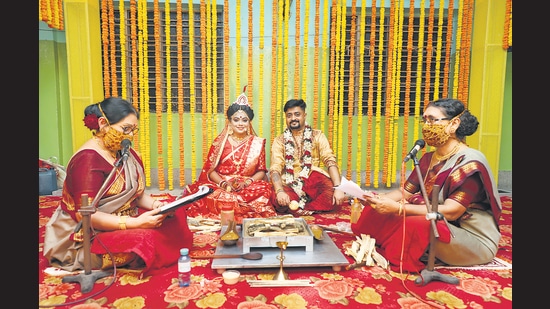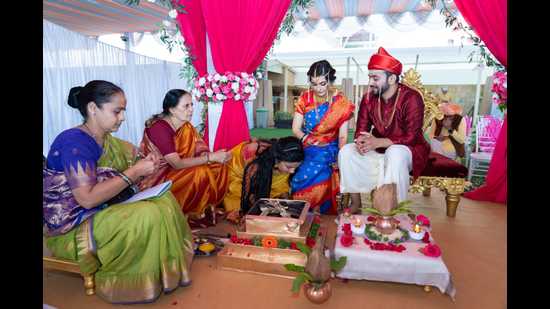On a wing and a prayer: How women priests are setting new norms
What do the prayers mean? Who gets to perform the rituals? Women priests are translating, demystifying, easing away barriers, at weddings, house-warmings and other ceremonies.
The option of simple vows in Hindi, Bengali or English; songs by Rabindranath Tagore about love and devotion; no kanyadaan; no bidaai; and a concluding note in which both partners mark each other’s foreheads with sindoor — these are some of the changes being normalised in wedding ceremonies, by women pujaris.

Though Hindu tradition does not forbid women from officiating as priests, there have been very few on record in India. Now, new women priests aren’t just raising that number, they’re also doing things differently.
Nandini, 60, who goes by only one name, has been a priest for more than a decade and heads a collective of women priests called Shubhamastu (Sanskrit for May It Prosper). Elsewhere, priests such as Suniti Gadgil and Sheela Atta are officiating in Maharashtra and south India respectively.
Atta was the officiant at actor Dia Mirza’s wedding this February. There was no kanyadaan, or “giving away” of the bride; no bidaai where the bride leaves her paternal home while “paying off her debt” to her parents by throwing grains of rice backwards as she leaves.
Sudipa Chakraborty, 32, a teacher from Rishra in West Bengal, had a similar ceremony, presided over by Nandini. “When she asked me to put the vermillion on my husband’s forehead first, as a sign of wishing him a good life, I felt so empowered. We felt that we broke the barrier of years of patriarchal traditions,” Chakraborty says.
IN WITH THE NEW
Nandini started her life as a priest by officiating at her daughter’s wedding, in 2010. She’s been a student of Sanskrit, a professor of Sanskrit and an Indologist. “I was always interested in the rituals and ceremonies. In 2009, while teaching Sanskrit at a Kolkata college, I met an old professor and Sankrit scholar, Gouri Dharmapal, who had formulated a very concise and simple version of the Indian Bengali Vedic wedding for priests and couples who wish to, to follow,” Nandini says. “She encouraged me to follow my passion of breaking the norms of patriarchy, and suggested I become a priest.”
The Vedic scriptures are the foundation of the women priests’ approach, with an effort at harmony between the genders, a sharing of ritual actions, and a move away from gendered ideas, which is why, for instance, Nandini does not perform the kanyadaan.
Incidentally, a growing number of male priests are also allowing couples to redraw gender lines and revise rituals. But to have a woman priest perform a less gendered ceremony is often, to some couples, a powerful statement in itself.
Typically, it is young couples who approach the women priests, sometimes in the face of resistance from family members. Rituparna Chakraborty Chatterjee, 27, a folk singer from Kolkata, was married by priests from Shubhamastu in July 2020. “Some people in my family raised questions but when they saw that singing Shyamasangeet [hymns of devotion to the goddess Kali] were part of our ceremony, they were really impressed and convinced, as we are a family of Kali devotees,” she says.
A 2020 Bengali feature film titled Brahma Janen Gopon Kommoti (from a popular Bengali song; loosely, “Brahma knows your secrets”), based on Nandini’s life, has helped break down barriers too. “We are now booked until March 2022 and do multiple ceremonies every month,” Nandini says.
Many cross-cultural couples prefer this approach, Nandini adds. “We translate mantras into English, which helps Bengalis from abroad who come to get married in India. The acceptance started coming from there in the beginning.”
In a major move for Shubhamastu, its women priests will be conducting Durga Puja rituals at 66 Pally Puja, a popular pandal in south Kolkata, in the festivities that begin on October 11.
SLOW AND STEADY
It’s been a longer journey for Suniti Gadgil, 68, who trained at Shankar Seva Samiti in Pune in the 1980s.

The Economics graduate had always been fascinated by puja rituals and wanted to spend her life performing them. But the first decade after her training was very difficult, she says. “Breaking what has been the norm for hundreds of years is not easy. What was surprising to me was that most of the resistance came from women,” Gadgil says. “I would accompany male priests to pujas and assist them. But it took me and my teachers years to convince families, particularly the women, to allow me to do pujas on my own.”
Her first solo ceremony was a wedding, in 1997. “It was a thrilling experience. Since then, I have conducted weddings in Dubai, Germany, Delhi, Madhya Pradesh, Maharashtra, Rajasthan, Gujarat.”
Anita Kulkarni, 64, a businesswoman from Pune, has known Gadgil for 25 years. “I first contacted her for the thread ceremony of my son. At that time engaging a woman priest was a novelty,” Kulkarni says. “But what makes her stand out among all the priests is her immaculate pronunciation. She takes great care to make the rituals simple and easy to understand even for the children. She’s like a family priest now.”
In December 2019, Kulkarni’s son married an American of Punjabi descent. “Sunitiji conducted the wedding and had a friend translate everything into English. My daughter-in-law was delighted, with a female priest especially,” Kulkarni says.
All Access.
One Subscription.
Get 360° coverage—from daily headlines
to 100 year archives.



HT App & Website






